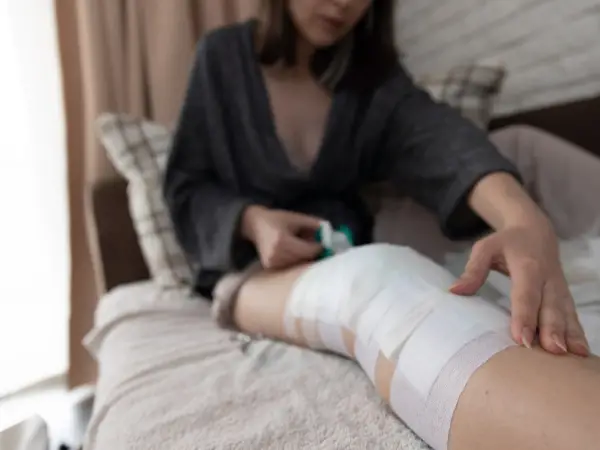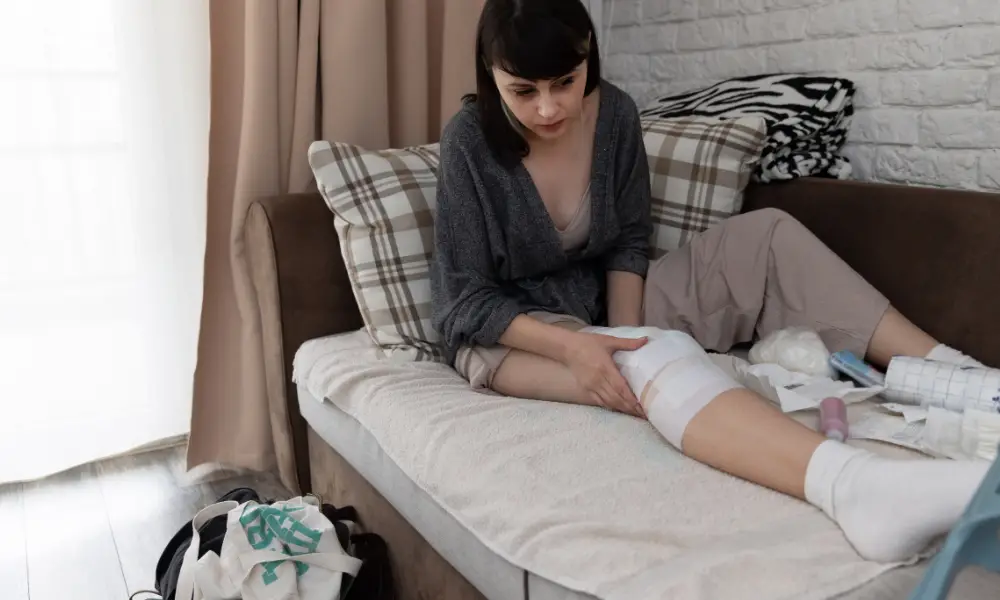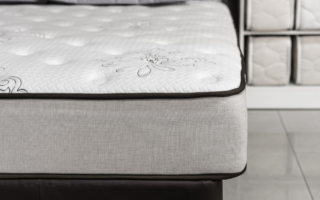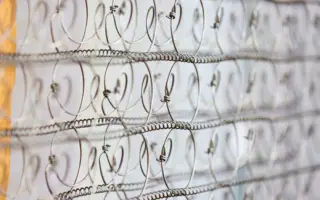To sleep safely after ACL reconstruction surgery, elevate your leg and use a pillow for support. Avoid twisting your knee during sleep.
Recovering from ACL reconstruction surgery involves not just daytime rehabilitation but also ensuring you get quality rest at night. Sleeping after such a procedure can be challenging due to discomfort and the fear of damaging the surgical site. Finding a comfortable sleeping position is crucial to avoid additional strain on your knee and to promote healing.
This guide provides tips on how to achieve restful sleep during your recovery period, emphasizing the importance of leg elevation and proper support. With the right approach, you can minimize pain and enhance your recovery experience, ensuring your knee heals properly and you return to your daily activities as soon as possible.
Preparation For Sleep
Getting a good night’s sleep after ACL reconstruction surgery is crucial for healing. Preparation for sleep plays a vital role in this process. It involves setting up a sleep-friendly environment and finding the right position for comfort and support. Here’s a guide to help you through the night without compromising your recovery.
Important: Be sure to consult your doctor.
Create A Comfortable Environment
Creating a soothing space is key for restful sleep after surgery. Start by ensuring your room is cool, dark, and quiet. Use blackout curtains to block light and consider earplugs or a white noise machine to drown out any disruptive sounds. Your mattress should be firm enough to support your body, including the surgically repaired knee.
- Keep a water bottle and pain medications within reach.
- Place a nightlight nearby to safely navigate if you need to get up.
- Arrange your pillows and blankets before you lie down to avoid unnecessary movements.
Below is a checklist to ensure your sleep environment promotes healing:
| Item | Details |
|---|---|
| Room Temperature | Keep it cool (around 65-70 degrees Fahrenheit) |
| Light | Use blackout curtains or an eye mask |
| Noise | Consider earplugs or a white noise machine |
| Accessibility | Water, medications, and nightlight within easy reach |
Positioning And Support
After ACL surgery, your knee needs to be supported correctly to prevent strain and promote healing. Always keep your knee in a neutral position while sleeping. Use pillows to prop up your leg, ideally above heart level, to reduce swelling. A body pillow or a wedge pillow can be especially helpful for maintaining the right position throughout the night.
- Place a pillow under your foot for elevation.
- Use a body pillow for side sleeping to keep your spine aligned.
- Avoid twisting movements by arranging pillows on both sides of your body.
See the table below for recommended sleep positions and their benefits:
| Sleep Position | Benefits |
|---|---|
| Back with knee elevated | Reduces swelling, supports natural leg alignment |
| Side with body pillow | Keeps spine straight, prevents leg from rolling |
| Semi-reclined | Comfort for those who find it difficult to lie flat |
Remember, never place a pillow directly under the knee. It can cause the joint to bend and hinder the healing process. Instead, support the calf and heel to keep the knee in a safe, neutral position. With these tips, you can look forward to a restful sleep and a smoother recovery.
Managing Pain
After ACL surgery, finding a comfy way to sleep is tough. The key? Managing pain. Let’s talk about how to ease pain for better sleep. This guide will help you rest well and heal fast.
Pain Management Plan
After surgery, controlling pain is a must for good sleep. Here’s a plan:
- Keep your leg raised. Use pillows to lift your leg. This reduces swelling.
- Use ice packs. Ice helps with pain and swelling. Wrap ice in cloth and apply for 20 minutes.
- Stay on a strict medication schedule. Don’t wait for pain to get bad.
- Do gentle exercises. They help with blood flow and reduce stiffness.
Set up your sleeping area before you go to bed. Make sure everything you need is close by. This way, you won’t have to get up often. Getting enough rest is crucial for healing.
Recommended Medications
Doctors often suggest certain meds for pain after ACL surgery. Here’s a list:
| Medication Type | Common Names | Notes |
|---|---|---|
| Pain Relievers | Acetaminophen | Good for mild pain. Doesn’t cause stomach issues. |
| NSAIDs | Ibuprofen, Naproxen | Helps with pain and swelling. Take with food. |
| Opioids | Varies | For severe pain. Follow doctor’s advice closely. |
Remember, medication should be part of your plan, not the whole plan. Stick to the schedule your doctor gives you. And, always talk to your doctor before changing or stopping meds. Your body needs care and time to heal well.
Movement And Rest
After an ACL reconstruction surgery, finding a comfortable sleeping position is vital. Your body heals during sleep, making it crucial to strike a balance between movement and rest. Proper rest helps reduce swelling and pain. On the other hand, gentle movements prevent stiffness and aid circulation. This safe sleep guide will help you navigate through the night post-surgery without compromising your recovery.
Balancing Rest And Activity
Rest is a cornerstone of recovery, but too much inactivity can be counterproductive. Balance is key. During the day, short walks help maintain blood flow, preventing blood clots. At night, focus on rest but incorporate small adjustments to avoid stiffness. Follow these tips for a balanced recovery:
- Set a sleep schedule: Aim for 7-9 hours of sleep and try to go to bed and wake up at the same time daily.
- Use pillows for support: Place pillows under your knee or calf to elevate the operated leg slightly, which can reduce swelling.
- Gradually increase activity: As your doctor allows, introduce light exercises to keep your joints mobile.
Remember to listen to your body. If pain increases, it’s a sign to slow down. Use the following table to schedule your rest and activity periods:
| Time | Activity | Rest |
|---|---|---|
| Morning | Light stretching | Breakfast in bed |
| Afternoon | Short walk | Elevate leg and rest |
| Evening | Gentle exercises | Relax with a book |
| Night | Limited movements | Uninterrupted sleep |
Avoiding Strenuous Movements
After ACL surgery, your knee is vulnerable. Avoiding strenuous movements is crucial to prevent re-injury. Here are steps to minimize risk:
- Keep movements smooth: No sudden twists or turns, especially at night when you’re less aware.
- Use crutches or a knee brace: These aids help you move safely without putting too much strain on your knee.
- Follow your physiotherapist’s advice: They provide tailored exercises that strengthen without overworking your knee.
Stay within these limits to protect your knee:
| Do’s | Don’ts |
|---|---|
| Wear your knee brace | Engage in high-impact sports |
| Use a stable chair for support | Sit with your knee bent for long periods |
| Apply ice to reduce swelling | Ignore persistent pain |
By steering clear of harmful actions, you give your knee the chance to heal effectively. Take care of your movements, and your body will thank you with a smooth recovery.

Sleeping Positions
Finding a comfortable sleeping position after ACL reconstruction surgery is crucial for recovery. A good night’s sleep helps your body heal. Let’s explore the best sleeping positions to ensure a safe and restful night.
Back Sleeping Position
Resting on your back is often recommended after ACL surgery. It’s a stable position that helps keep your knee straight, which is vital for healing. Here are key points to remember:
- Support your knee: Place a pillow under your operated leg to keep it slightly elevated.
- Maintain alignment: Your hips and shoulders should be in a straight line to avoid strain.
- Use a firm mattress: A supportive surface helps maintain proper posture while you sleep.
Benefits of back sleeping include reduced pressure on the knee and better alignment of the spine. Ensure you have enough pillows to keep your leg elevated throughout the night. Remember to avoid twisting movements. Below is a table that outlines the do’s and don’ts of back sleeping after ACL surgery:
| Do’s | Don’ts |
|---|---|
| Elevate your leg | Place pillows under your knee |
| Keep your leg straight | Let your leg hang off the bed |
| Use a firm mattress | Sleep on a soft or sagging mattress |
Side Sleeping Position
Side sleeping can also be comfortable post-ACL surgery, but it requires caution. Here’s how to do it safely:
- Choose the right side: Sleep on the non-operated side to prevent pressure on the healing knee.
- Use pillows for support: Place a pillow between your legs to keep your hips aligned and support your knee.
- Control your movements: Gentle movements are key to prevent any strain on your knee.
Advantages of side sleeping include comfort and better circulation. Be mindful of your body’s position throughout the night. A table below shows the do’s and don’ts for side sleeping after ACL surgery:
| Do’s | Don’ts |
|---|---|
| Sleep on the non-operated side | Apply pressure on the operated knee |
| Place a pillow between your legs | Cross your legs or ankles |
| Keep movements gentle | Make sharp or sudden movements |
Assistive Devices
Sleeping after ACL reconstruction surgery can be tough. Your knee needs the right support to heal. This is where assistive devices come in. They help you get the rest you need while keeping your knee safe. Let’s talk about pillows, supports, braces, and splints. These tools can make all the difference for a good night’s sleep.
Use Of Pillows And Supports
Pillows and supports are key for sleeping after ACL surgery. They keep your leg in the right spot. This helps with swelling and pain. Here’s how to use them:
- Elevate your knee – Place pillows under your leg. This will keep it higher than your heart.
- Keep your knee straight – Don’t let your knee bend. It might hurt your healing.
You can also use foam wedges. They give firm support and keep your leg still. Here’s a table with suggested pillow setups:
| Position | Pillow Type | Benefits |
|---|---|---|
| Under knee | Memory foam pillow | Comfort and reduced swelling |
| Behind back | Supportive back pillow | Helps maintain position |
| Under foot | Small cushion | Prevents pressure on the heel |
Remember, the setup should feel comfy for you. Adjust as needed!
Bracing Or Splinting
Braces and splints keep your knee safe after ACL surgery. They help in many ways. Let’s break it down:
- Stabilize your joint – They stop your knee from moving the wrong way.
- Protect the repair – They shield your knee from bumps or twists.
Your doctor will tell you what kind of brace or splint to use. Some are for all-day use. Others are just for sleeping. Here are some tips:
- Wear your brace as told by your doctor.
- Check that it’s not too tight. You don’t want to stop your blood flow.
- Make sure it’s comfy. Adjust the straps if you need to.
Braces come in different types. Hinged braces let your knee bend a bit. Rigid braces keep it straight. Your doctor will pick the best one for you. Always follow their advice for the best healing.
Sleeping Aids
Getting good sleep after ACL reconstruction surgery is crucial for recovery. Pain and discomfort can disrupt sleep patterns. This guide aims to help with safe and effective sleeping aids. These tips will ease pain and promote healing during the night.
Use Of Ice Packs Or Heating Pads
Managing pain and swelling is key to a restful night after ACL surgery. Here are some helpful tips:
- Ice packs reduce swelling and numb the pain. Use them for 20 minutes before bed.
- Heating pads can relax muscles. They are best used a few hours before sleeping.
Remember to:
| Do’s | Don’ts |
|---|---|
| Wrap ice packs in cloth | Apply ice directly on skin |
| Check skin regularly | Use heating pads while sleeping |
| Use a timer for application | Ignore pain during application |
Alternating between cold and heat therapy can be very effective. It’s best to discuss this with your doctor.
Relaxation Techniques
Relaxation before bed can improve sleep quality. Here are some techniques:
- Deep breathing: Take slow, deep breaths to calm your mind.
- Progressive muscle relaxation: Tense and relax each muscle group, starting from your toes up to your head.
- Meditation: Focus on your breath or a calming sound to ease your thoughts.
Creating a bedtime routine also helps:
- Dim the lights an hour before bed.
- Read a book or listen to soft music.
- Avoid screens and bright lights.
These activities signal your body that it’s time to sleep. They help your mind and body prepare for rest.
Sleep Hygiene
Good sleep is crucial after ACL reconstruction surgery. It helps your body heal and recover faster. Yet, finding a comfortable position can be a challenge. Sleep hygiene can make a big difference. It’s about habits that lead to better sleep quality. This guide covers simple steps to improve rest after surgery. Let’s dive into sleep hygiene and how it can help you post-ACL surgery.
Establishing A Bedtime Routine
A bedtime routine signals your body it’s time to wind down. Here are key steps to create one:
- Set a fixed sleep time: Go to bed at the same time each night.
- Relax before bed: Engage in calming activities. Read a book or listen to soft music.
- Keep your room cool and dark: A comfortable environment is vital for sleep.
Here’s a bedtime routine example:
| Time | Activity |
|---|---|
| 9:30 PM | Dim lights, start relaxing |
| 10:00 PM | Read a book or meditate |
| 10:30 PM | Lights out, try to sleep |
Remember to make your bed comfy. Use pillows to support your knee. Keep your sleep space quiet for the best rest.
Limiting Screen Time
Screens can keep your mind active when you should be sleeping. The blue light from devices can mess with sleep patterns. Here’s how to limit screen time for better rest:
- Turn off screens an hour before bed: This helps your brain relax.
- Use “night mode”: If you must use a device, activate the night setting to reduce blue light.
- Avoid stimulating content: Choose calming shows or music if you watch or listen to something.
Consider these tips to cut down on screen time:
| Screen Time Limit | Benefit |
|---|---|
| No TV in the bedroom | Makes sleep the main focus |
| Read instead of scrolling | Less blue light, more relaxing |
| Set a device curfew | Encourages natural sleepiness |
Stick to these limits to help your body get the rest it needs. Your sleep will improve, and so will your recovery.
Frequently Asked Questions
How To Sleep At Night After Acl Surgery?
Elevate your leg using pillows to reduce swelling. Take prescribed pain medication as directed. Use a cold compress to ease discomfort. Sleep on your back initially, and keep your brace on if advised by your doctor. Ensure a comfortable, supportive mattress.
What Is The Most Comfortable Sleeping Position After Acl Surgery?
Sleeping on your back with the knee slightly elevated is the most comfortable position after ACL surgery. Use pillows under your knee for support. This posture helps reduce swelling and promotes healing. Always consult your doctor for personalized advice.
Can I Sleep With A Pillow Under My Knee After Acl Surgery?
Yes, after ACL surgery, you can sleep with a pillow under your knee to promote comfort and reduce swelling. Always follow your surgeon’s specific post-operative instructions.
What Is The Best Position To Sleep After Knee Surgery?
The best position to sleep after knee surgery is on your back with a pillow under your knee to keep it slightly elevated. This reduces swelling and aids in joint recovery. Always follow your surgeon’s specific advice for optimal healing.
Conclusion
Restful sleep is crucial for recovery after ACL surgery. By following the tips shared, you can enhance your comfort and safety. Remember to adjust your sleeping position, use supportive pillows, and manage pain responsibly. Prioritize these steps to improve your sleep quality and aid your healing journey.
Sweet dreams and speedy recovery!



